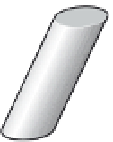Geoscience Reference
In-Depth Information
depending on the length L (see
Section 2.11.1.3
). Multiple
bodies can be arranged as an ensemble to simulate a wider
variety of realistic 3D geological forms.
During modelling, a body
a)
b)
c)
L
L
L
s parameters, i.e. its dimen-
sions, position and physical property, are varied. These
models are also known as parametric models and they
make for quick and easy modelling, but their simplicity
means a perfect match with the observed data may not be
achievable. This is not necessarily a problem, because the
results obtained are a good starting point for building more
complex models.
Parametric models include sheets of different thickness
(flat, dipping or vertical), dipping contact (sometimes
called a step or fault) and a cylinder (vertical, horizontal
or plunging) which when thin becomes a disc. The ellips-
oid is a particularly useful model. It is an easy matter to
stretch and rotate its axes to approximate a range of
geological forms such as a plunging pipe-like ore shoot, a
flat-lying stratiform orebody, or its axes extended equally
to form a sphere to represent equidimensional bodies.
More complex models can be built using bodies whose
surfaces are de
ned by a series of interconnecting planar
specifying the coordinates of the vertices of the individual
facets, which are adjusted during modelling. This provides
more
flexibility for creating complex shapes, but manipu-
lation of the model is then more complicated. By con-
structing a model with multiple bodies of this type,
complex and realistic geology can be modelled:
'
d)
e)
f)
L
L
g)
h)
i)
k)
l)
j)
L
Figure 2.44
Shape-based models. (a) Thin vertical sheet, (b) thick
vertical sheet, (c) thin horizontal sheet, (d) step, fault or dipping
contact model, (e) horizontal cylinder, (f) plunging cylinder, (g) disc,
(h) sphere, (i) ellipsoid, (j) irregular prism, (k) and (l) facet models.
To model a set of geophysical data the interpreter must
select an appropriate model to represent the subsurface
geology. There are two classes of geophysical model:
shape-based models and cell-based models. In most cases,
notably modelling of gravity and magnetic data, the model
response is obtained by summing the responses of the
ensemble of constituent shapes or cells. The situation is
not as simple for electrical and electromagnetic methods
where complex interaction between the different compon-
ents of the model, and with the host rocks, strongly in
u-
ences the model
see
2.11.1.2
Cell-based models
Complex physical property models can be created by rep-
resenting the entire subsurface as a series of discrete cells
or elements whose properties are homogeneous through-
out the cell/element (
Fig. 2.45a
and
b
). A physical property
value is assigned to each cell and the data are modelled by
adjusting only these values; the cell geometry and positions
remain unchanged. The interpreter can de
ne complex
geological features on sections and on layers of cells. It is
important that models of this type extend well beyond the
area of interest to prevent
'
s overall response.
2.11.1.1
Shape-based models
Models consisting of geometrically simple bodies
(
Fig. 2.44a
to
i
)
, each assigned a particular physical prop-
erty value, are appropriate when a simple homogeneous
form is considered to be a reasonable approximation of the
shape of the anomaly source, or when too little is known
about the subsurface geology and its physical properties to
justify a more complex model. Models (a) to (e) and (j) in
Fig. 2.44
may be used for 2D and 2.5D modelling,
due to the abrupt
change in physical properties at the edge of the model. The
challenge of manually manipulating the large number of
cells repetitively generally restricts these types of models to
inverse modelling (see
Section 2.11.2.1
).
A variant of this model type represents the subsurface as
a series of cells whose dimensions are varied in only one
'
edge effects
'




















































































Search WWH ::

Custom Search